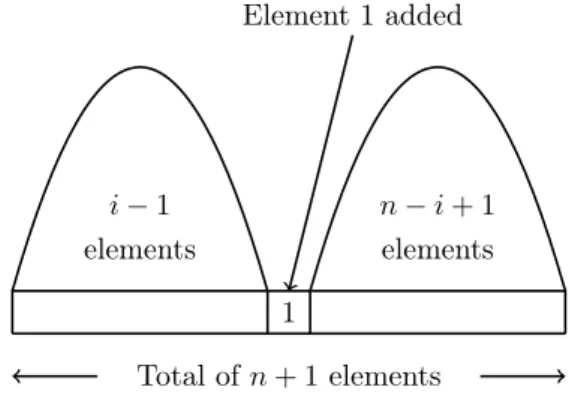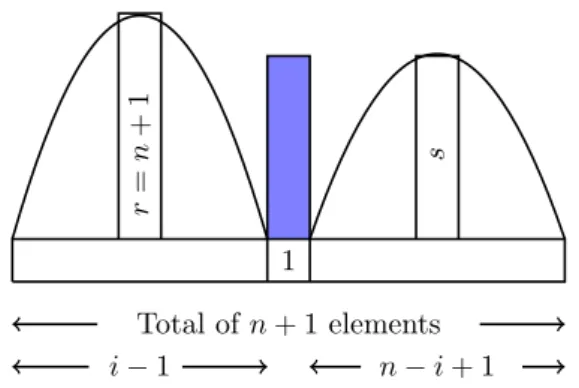Contents
Research papers
L. Belarbi,Surfaces with constant extrinsically Gaussian curvature in the Heisenberg group . . . 5 Cs. Biró, G. Kusper,Somek-hop based graph metrics and node ranking
in wireless sensor networks . . . 19 A. Blecher, C. Brennan, A. Knopfmacher, M. Shattuck,Capacity
of permutations . . . 39 F. Erduvan, R. Keskin, Fibonacci numbers which are products of two
balancing numbers . . . 57 Á. Figula, K. Ficzere, A. Al-Abayechi, Topological loops with six-
dimensional solvable multiplication groups having five-dimensional nil- radical . . . 71 D. Fülöp, C. Hannusch,Algorithm for the generation of complement-free
sets . . . 89 I. Juhász,On the caustics of Bézier curves . . . 93 A. C. G. Lomelí, S. H. Hernández, F. Luca,Pillai’s problem with the
Fibonacci and Padovan sequences . . . 101 A. Lovas, R. Nagy, P. Sótonyi, B. Szilágyi,Volumetric flow rate re-
construction in great vessels . . . 117 F. Luca, S. V. Togan, A. Togbé,On theX-coordinates of Pell equations
which are rep-digits, II . . . 131 J. K. Merikoski, P. Haukkanen, T. Tossavainen, Arithmetic sub-
derivatives and Leibniz-additive functions . . . 145 A. Noubissie, A. Togbé,A note on the exponential Diophantine equation
(an−1)(bn−1) =x2 . . . 159 S. E. Rihane, B. Faye, F. Luca, A. Togbé,An exponential Diophantine
equation related to the difference between powers of two consecutive Balancing numbers . . . 167 T. Tómács, A Marcinkiewicz–Zygmund type strong law of large numbers
for non-negative random variables with multidimensional indices . . . . 179 Á. Tóth, R. Karimi, Optimization of hadoop cluster for analyzing large-
scale sequence data in bioinformatics . . . 187 Methodological papers
E. Gyöngyösi-Wiersum, Z. Makó Czapné, G. Makrides, Situation games to ease transition between abstract and real life mathematics for primary school student teachers . . . 205 Á. Győry, E. Kónya, Proving skills in geometry of secondary grammar
school leavers specialized in mathematics . . . 217
ANNALESMATHEMATICAEETINFORMATICAE50.(2019)
ANNALES
MATHEMATICAE ET INFORMATICAE
TOMUS 50. (2019)
COMMISSIO REDACTORIUM
Sándor Bácsó (Debrecen), Sonja Gorjanc (Zagreb), Tibor Gyimóthy (Szeged), Miklós Hoffmann (Eger), József Holovács (Eger), Tibor Juhász (Eger), László Kovács (Miskolc), László Kozma (Budapest), Kálmán Liptai (Eger), Florian Luca (Mexico), Giuseppe Mastroianni (Potenza), Ferenc Mátyás (Eger),
Ákos Pintér (Debrecen), Miklós Rontó (Miskolc), László Szalay (Sopron), János Sztrik (Debrecen), Gary Walsh (Ottawa)
HUNGARIA, EGER
MATHEMATICAE ET INFORMATICAE
VOLUME 50. (2019)
EDITORIAL BOARD
Sándor Bácsó (Debrecen), Sonja Gorjanc (Zagreb), Tibor Gyimóthy (Szeged), Miklós Hoffmann (Eger), József Holovács (Eger), Tibor Juhász (Eger), László Kovács (Miskolc), László Kozma (Budapest), Kálmán Liptai (Eger), Florian Luca (Mexico), Giuseppe Mastroianni (Potenza), Ferenc Mátyás (Eger),
Ákos Pintér (Debrecen), Miklós Rontó (Miskolc), László Szalay (Sopron), János Sztrik (Debrecen), Gary Walsh (Ottawa)
INSTITUTE OF MATHEMATICS AND INFORMATICS ESZTERHÁZY KÁROLY UNIVERSITY
HUNGARY, EGER
A kiadásért felelős az Eszterházy Károly Egyetem rektora Megjelent a Líceum Kiadó gondozásában
Kiadóvezető: Nagy Andor Felelős szerkesztő: Zimányi Árpád Műszaki szerkesztő: Tómács Tibor
Megjelent: 2019. december
Surfaces with constant extrinsically
Gaussian curvature in the Heisenberg group
Lakehal Belarbi
Department of Mathematics,
Laboratory of Pure and Applied Mathematics, University of Mostaganem (U.M.A.B.), Mostaganem, Algeria
lakehalbelarbi@gmail.com Submitted: September 19, 2017 Accepted: January 23, 2019 Published online: February 11, 2019
Abstract
In this work we study constant extrinsically Gaussian curvature transla- tion surfaces in the 3-dimensional Heisenberg group which are invariant under the 1-parameter groups of isometries.
Keywords:Constant extrinsically Gaussian curvature Surfaces, Homogeneous group.
MSC:49Q20 53C22.
1. Introduction
In 1982, W. P. Thurston formulated a geometric conjecture for three dimensional manifolds, namely every compact orientable 3-manifold admits a canonical decom- position into pieces, each of them having a canonical geometric structure from the following eight maximal and simply connected homogenous Riemannian spaces:
E3,S3,H3,S2×R,H2×R, 𝑆𝐿(2,R),H3 and𝑆𝑜𝑙3. See e.g. [34].
During the recent years, there has been a rapidly growing interest in the geom- etry of surfaces in three homogenous spaces focusing on flat and constant Gaussian curvature surfaces. Many works are studying the geometry of surfaces in homoge- neous 3-manifolds. See for example [2–4, 9, 12, 14–16, 21, 22, 24, 36].
The concept of translation surfaces inR3can be generalized the surfaces in the three dimensional Lie group, in particular, homogeneous manifolds. In Euclidean doi: 10.33039/ami.2019.01.001
http://ami.uni-eszterhazy.hu
5
3-space, every cylinder is flat. Conversely, complete flat surfaces inE3are cylinders over complete curves. See [20]. López and Munteanu [17] studied invariant surfaces with constant mean curvature and constant Gaussian curvature in𝑆𝑜𝑙3space. Yoon and Lee [37] studied translation surfaces in Heisenberg group H3 whose position vector𝑥satisfies the equation∆𝑥=𝐴𝑥,where∆is the Laplacian operator of the surface and𝐴is a3×3-real matrix.
Flat 𝐺4-invariant surfaces are nothing but surfaces invariant under 𝑆𝑂(2)- action, i.e. rotational surfaces. Flat rotational surfaces are classified by Caddeo, Piu and Ratto in [8].
In [14], J. I. Inoguchi give a classification of intrinsically flat𝐺1-invariant trans- lation surfaces in Heisenberg group H3. Let 𝑀 be a surface invariant under 𝐺3, then𝑀 is locally expressed as
𝑋(𝑢, 𝑣) = (0,0, 𝑣).(𝑥(𝑢), 𝑦(𝑢),0) = (𝑥(𝑢), 𝑦(𝑢), 𝑣), 𝑢∈𝐼, 𝑣∈R.
Here 𝐼 is an open interval and𝑢 is the arclength parameter. Note that (𝑥, 𝑦,0) and (0,0, 𝑣) commute. Then the sectional curvature 𝐾(𝑋𝑥∧𝑋𝑦) = 14 and the extrinsically Gaussian curvature 𝐾𝑒𝑥𝑡 =−14. Direct computation show that 𝑀 is flat. (cf. [12–14, 28]).
The paper is divided according the type of surfaces invariant under 1-parameter subgroups of isometries {𝐺𝑖}𝑖=1,2,3,4. So, in section 3 we classify 𝐺1-invariant surfaces of the Heisenberg groupH3with constant extrinsically Gaussian curvature 𝐾𝑒𝑥𝑡,including extrinsically flat𝐺1-invarinant surfaces.
In section4we classify 𝐺2-invariant surfaces of the Heisenberg groupH3 with constant extrinsically Gaussian curvature 𝐾𝑒𝑥𝑡, including extrinsically flat 𝐺2- invariant surfaces.
2. Preliminaries
The 3-dimensional Heisenberg group H3 is the simply connected and connected 2-step nilpotent Lie group. Which has the following standard representation in
𝐺𝐿(3,R) ⎛
⎝ 1 𝑟 𝑡 0 1 𝑠 0 0 1
⎞
⎠
with𝑟, 𝑠, 𝑡∈R. The Lie algebrah3ofH3 is given by the matrices
𝐴=
⎛
⎝ 0 𝑥 𝑧 0 0 𝑦 0 0 0
⎞
⎠
with 𝑥, 𝑦, 𝑧 ∈ R.The exponential map 𝑒𝑥𝑝 :h3 → H3 is a global diffeomorphism, and is given by
exp(𝐴) =𝐼+𝐴+𝐴2 2 =
⎛
⎝ 1 𝑥 𝑧+𝑥𝑦2
0 1 𝑦
0 0 1
⎞
⎠.
The Heisenberg group H3 is represented as the cartesian 3-space R3(𝑥, 𝑦, 𝑧) with group structure:
(𝑥1, 𝑦1, 𝑧1).(𝑥2, 𝑦2, 𝑧2) :=
(︂
𝑥1+𝑥2, 𝑦1+𝑦2, 𝑧1+𝑧2+1
2𝑥1𝑦2−1 2𝑥2𝑦1
)︂
. We equipH3 with the following left invariant Riemannian metric
𝑔:=𝑑𝑥2+𝑑𝑦2+ (︂
𝑑𝑧+1
2(𝑦𝑑𝑥−𝑥𝑑𝑦) )︂2
.
The identity component 𝐼∘(H3) of the full isometry group of (H3, 𝑔) is the semi-direct product𝑆𝑂(2)n H3.The action of𝑆𝑂(2)n H3 is given explicitly by
𝐴=
⎛
⎝[︂
cos𝜃 −sin𝜃 sin𝜃 cos𝜃
]︂
.
⎡
⎣ 𝑎 𝑏 𝑐
⎤
⎦
⎞
⎠.
⎡
⎣ 𝑥 𝑦 𝑧
⎤
⎦
=
⎡
⎣ cos𝜃 −sin𝜃 0
sin𝜃 cos𝜃 0
1
2(𝑎sin𝜃−𝑏cos𝜃) 12(𝑎cos𝜃+𝑏sin𝜃) 1
⎤
⎦.
⎡
⎣ 𝑥 𝑦 𝑧
⎤
⎦+
⎡
⎣ 𝑎 𝑏 𝑐
⎤
⎦.
In particular, rotational around the 𝑧-axis and translations:
(𝑥, 𝑦, 𝑧)→(𝑥, 𝑦, 𝑧+𝑎), 𝑎∈R along the𝑧-axis are isometries of H3.
The Lie algebrah3of𝐼∘(H3)is generated by the following Killing vector fields:
𝐹1= 𝜕
𝜕𝑥 +𝑦 2
𝜕
𝜕𝑧, 𝐹2= 𝜕
𝜕𝑦 −𝑥 2
𝜕
𝜕𝑧, 𝐹3= 𝜕
𝜕𝑧, 𝐹4=−𝑦 𝜕
𝜕𝑥 +𝑥𝜕
𝜕𝑦.
One can check that𝐹1, 𝐹2, 𝐹3are infinitesimal transformations of the 1-parameter groups of isometries defined by
𝐺1={(𝑡,0,0)|𝑡∈R}, 𝐺2={(0, 𝑡,0)|𝑡∈R}, 𝐺3={(0,0, 𝑡)|𝑡∈R}, respectively. Here this groups acts onH3 by the left translation. The vector field 𝐹4 generates the group of rotations around the𝑧-axis. Thus 𝐺4 is identified with 𝑆𝑂(2).
Definition 2.1. A surfaceΣ in the Heisenberg space H3 is said to be invariant surface if it is invariant under the action of the 1-parameter subgroups of isometries {𝐺𝑖},with𝑖∈ {1,2,3,4}.
The Lie algebrah3ofH3 has an orthonormal basis{𝐸1, 𝐸2, 𝐸3}defined by 𝐸1= 𝜕
𝜕𝑥−𝑦 2
𝜕
𝜕𝑧, 𝐸2= 𝜕
𝜕𝑦 +𝑥 2
𝜕
𝜕𝑧, 𝐸3= 𝜕
𝜕𝑧.
The Levi-Civita connection ∇ of 𝑔,in terms of the basis {𝐸𝑖}𝑖=1,2,3 is explicitly given as follows
⎧⎨
⎩
∇𝐸1𝐸1= 0,∇𝐸1𝐸2=12𝐸3,∇𝐸1𝐸3=−12𝐸2
∇𝐸2𝐸1=−12𝐸3,∇𝐸2𝐸2= 0,∇𝐸2𝐸3= 12𝐸1
∇𝐸3𝐸1=−12𝐸2,∇𝐸3𝐸2= 12𝐸1,∇𝐸3𝐸3= 0 The Riemannian curvature tensor𝑅 is a tensor field onH3 defined by
𝑅(𝑋, 𝑌)𝑍=∇𝑋∇𝑌𝑍− ∇𝑌∇𝑋𝑍− ∇[𝑋,𝑌]𝑍.
The components{𝑅𝑙𝑖𝑗𝑘} are computed as 𝑅1212=−3
4, 𝑅1313=1
4, 𝑅2323= 1 4.
Let us denote𝐾𝑖𝑗 =𝐾(𝐸𝑖, 𝐸𝑗)the sectional curvature of the plane spanned by𝐸𝑖
and𝐸𝑗.Then we get easily the following:
𝐾12=−3
4, 𝐾13=−1
4, 𝐾23=−1 4. The Ricci curvature 𝑅𝑖𝑐is defined by
𝑅𝑖𝑐(𝑋, 𝑌) =𝑡𝑟𝑎𝑐𝑒{𝑍 →𝑅(𝑍, 𝑋)𝑌}. The components{𝑅𝑖𝑗}of𝑅𝑖𝑐are defined by
𝑅𝑖𝑐(𝐸𝑖, 𝐸𝑗) =𝑅𝑖𝑗=
∑︁3 𝑘=1
⟨𝑅(𝐸𝑖, 𝐸𝑘)𝐸𝑘, 𝐸𝑗⟩.
The components{𝑅𝑖𝑗}are computed as 𝑅11=−1
2, 𝑅12=𝑅13=𝑅23= 0, 𝑅22=−1
2, 𝑅33= 1 2. The scalar curvature𝑆 of H3 is constant and we have
𝑆 =𝑡𝑟𝑅𝑖𝑐=
∑︁3 𝑖=1
𝑅𝑖𝑐(𝐸𝑖, 𝐸𝑖) =−1 2.
3. Constant extrinsically Gaussian curvature
𝐺
1-invariant translation surfaces in Heisenberg group H H H
3333.1.
In this subsection we study complete extrinsically flat translation surfaces Σ in Heisenberg group H3 which are invariant under the one parameter subgroup𝐺1. Clearly, such a surface is generated by a curve 𝛾 in the totally geodesic plane {𝑥= 0}. Discarding the trivial case of a vertical plane {𝑦 =𝑦0}. Thus𝛾 is given by𝛾(𝑦) = (0, 𝑦, 𝑣(𝑦)). Therefore the generated surface is parameterized by
𝑋(𝑥, 𝑦) = (𝑥,0,0).(0, 𝑦, 𝑣(𝑦)) = (𝑥, 𝑦, 𝑣(𝑦) +𝑥𝑦
2 ), (𝑥, 𝑦)∈R2. We have an orthogonal pair of vector fields on(Σ),namely,
𝑒1:=𝑋𝑥= (1,0,𝑦
2) =𝐸1+𝑦𝐸3. and
𝑒2:=𝑋𝑦= (0,1, 𝑣′+𝑥
2) =𝐸2+𝑣′𝐸3. The coefficients of the first fundamental form are:
𝐸=⟨𝑒1, 𝑒1⟩= 1 +𝑦2, 𝐹 =⟨𝑒1, 𝑒2⟩=𝑦𝑣′, 𝐺=⟨𝑒2, 𝑒⟩= 1 +𝑣′2. As a unit normal field we can take
𝑁 = −𝑦
√︀1 +𝑦2+𝑣′2𝐸1− 𝑣′
√︀1 +𝑦2+𝑣′2𝐸2+ 1
√︀1 +𝑦2+𝑣′2𝐸3
The covariant derivatives are
∇̃︀𝑒1𝑒1=−𝑦𝐸2
∇̃︀𝑒1𝑒2=𝑦
2𝐸1−𝑣′ 2𝐸2+1
2𝐸3
∇̃︀𝑒2𝑒2=𝑣′𝐸1+𝑣′′𝐸3. The coefficients of the second fundamental form are 𝑙=⟨∇̃︀𝑒1𝑒1, 𝑁⟩= 𝑦𝑣′
√︀1 +𝑦2+𝑣′2
𝑚=⟨∇̃︀𝑒1𝑒2, 𝑁⟩= −𝑦22 +𝑣2′2 +12
√︀1 +𝑦2+𝑣′2
𝑛=⟨∇̃︀𝑒2𝑒2, 𝑁⟩= −𝑦𝑣′+𝑣′′
√︀1 +𝑦2+𝑣′2.
Let𝐾𝑒𝑥𝑡be the extrinsic Gauss curvature ofΣ, 𝐾𝑒𝑥𝑡= 𝑙𝑛−𝑚2
𝐸𝐺−𝐹2 = −𝑦2𝑣′2+𝑦𝑣′𝑣′′−(−𝑦22 +𝑣2′2 +12)2 (1 +𝑦2+𝑣′2)2 .
ThusΣis extrinsically flat invariant surface in Heisenberg groupH3 if and only if 𝐾𝑒𝑥𝑡= 0,
that is, if and only if
−𝑦2𝑣′2+𝑦𝑣′𝑣′′− (︂
−𝑦2 2 +𝑣′2
2 +1 2
)︂2
= 0 (3.1)
to classify extrinsically flat invariant surfaces must solve the equation (3.1). We can writes equation (3.1) as
𝑦2+𝑦𝑣′𝑣′′− (︂𝑦2
2 +𝑣′2 2 +1
2 )︂2
= 0 (3.2)
we assume that𝑧= 𝑦22 +𝑣2′2+12. Then
⎧⎨
⎩
𝑧′=𝑦+𝑣′𝑣′′
𝑣′𝑣′′=𝑧′−𝑦 𝑣′2= 2𝑧−𝑦2−1.
(3.3) Therefore equation (3.2) becomes
𝑦𝑧′−𝑧2= 0. (3.4)
equation (3.4) implies that
−𝑧′ 𝑧2 =−1
𝑦. (3.5)
and equation (3.5) implies that
𝑧= 1
−ln(𝑦) +𝛼. (3.6)
where𝛼∈R,and if𝑦̸=𝑒𝛼. From (3.3) and (3.6), we have
𝑣′2= 2𝑧−𝑦2−1
= 2
−ln(𝑦) +𝛼−𝑦2−1.
Thus
𝑣′=
√︃ 2
−ln(𝑦) +𝛼−𝑦2−1.
As conclusion, we have
Theorem 3.1. ∙The only non-extendable extrinsically flat translation surfaces in the 3-dimensional Heisenberg group H3 invariant under the 1-parameter subgroup 𝐺1 ={(𝑡,0,0)∈ H3/𝑡∈R}, are the surfaces whose parametrization is 𝑋(𝑥, 𝑦) = (︀𝑥, 𝑦, 𝑣(𝑦) +𝑥𝑦2)︀where 𝑦 and𝑣 satisfy
𝑣(𝑦) =
∫︁ √︃ 2
−ln(𝑦) +𝛼−𝑦2−1𝑑𝑦.
where𝛼∈R, and𝑦̸=𝑒𝛼.
∙There are no complete extrinsically flat translation surfaces in the 3-dimensio- nal Heisenberg groupH3invariant under the 1-parameter subgroup𝐺1={(𝑡,0,0)∈ H3/𝑡∈R}.
Remark 3.2. Let Σ be a 𝐺1-invariant translation surfaces in the 3-dimensional Heisenberg space. ThenΣis locally expressed as
𝑋(𝑥, 𝑦) = (0, 𝑦, 𝑣(𝑦)).(𝑥,0,0) =(︁
𝑥, 𝑦, 𝑣(𝑦)−𝑥𝑦 2
)︁.
Then the extrinsically Gaussian curvature𝐾𝑒𝑥𝑡 ofΣis computed as 𝐾𝑒𝑥𝑡=
(︀(𝑣′−𝑥)2−1)︀2
4 (1 + (𝑣′−𝑥)2)2.
ThusΣcan not be of constant extrinsically Gaussian curvature.
3.2.
In this subsection we study complete constant extrinsically Gaussian curvature translation surfaces Σin Heisenberg group H3 which are invariant under the one parameter subgroup 𝐺1. Clearly, such a surface is generated by a curve𝛾 in the totally geodesic plane {𝑥 = 0}. Discarding the trivial case of a vertical plane {𝑦=𝑦0}. Thus 𝛾 is given by𝛾(𝑦) = (0, 𝑦, 𝑣(𝑦)). Therefore the generated surface is parameterized by
𝑋(𝑥, 𝑦) = (𝑥,0,0).(0, 𝑦, 𝑣(𝑦)) = (𝑥, 𝑦, 𝑣(𝑦) +𝑥𝑦
2 ), (𝑥, 𝑦)∈R2.
Theorem 3.3. ∙The𝐺1-invariant constant extrinsically Gaussian curvature trans- lation surfaces in the 3-dimensional Heisenberg groupH3, are:
1. 𝐾𝑒𝑥𝑡=−14.
The surfaces of equation 𝑧=𝑣(𝑦) +𝑥𝑦
2 = 𝑥𝑦 2 +1
2𝑦√︀
2𝛽−𝑦2+ arctan (︃ 𝑦
√︀𝛽−𝑦2 )︃
, where𝛽∈R.
2. 𝐾𝑒𝑥𝑡̸=−14.
Then𝑦 and𝑣 satisfy 𝑣(𝑦) =
∫︁ √︃ 1
−2(𝐾𝑒𝑥𝑡+14) ln(𝑦) +𝛾 −𝑦2−1𝑑𝑦.
where𝛾∈R,and𝑦̸=𝑒
𝛾 2(𝐾𝑒𝑥𝑡+ 14).
∙ There are no complete constant extrinsically Gaussian curvature translation sur- faces in the 3-dimensional Heisenberg group H3 invariant under the 1-parameter subgroup 𝐺1.
Proof. From (4.1) and (3.2) we have 𝐾𝑒𝑥𝑡= 𝑙𝑛−𝑚2
𝐸𝐺−𝐹2 = 𝑦2+𝑦𝑣′𝑣′′−14
(︀1 +𝑦2+𝑣′2)︀2
(1 +𝑦2+𝑣′2)2 . (3.7) 1. If 𝐾𝑒𝑥𝑡=−14. Then equation (3.7) becomes
𝑦2+𝑦𝑣′𝑣′′= 0 (3.8)
We note that𝑦 equal zero is solution of the equation(3.8).
If𝑦is different to zero(𝑦̸= 0), equation (3.8) becomes 𝑣′𝑣′′=−𝑦.
Integration gives us 𝑣(𝑦) =1
2𝑦√︀
2𝛽−𝑦2+ arctan (︃ 𝑦
√︀𝛽−𝑦2 )︃
, where𝛽∈R.
2. If 𝐾𝑒𝑥𝑡̸=−14. Then equation (3.7) becomes 𝑦2+𝑦𝑣′𝑣′′= (𝐾𝑒𝑥𝑡+1
4)(1 +𝑦2+𝑣′2)2. In fact, put𝑧= 1 +𝑦2+𝑣′2. Then𝑧 satisfies
1
2𝑦𝑧′ = (𝐾𝑒𝑥𝑡+1 4)𝑧2. Hence we have
𝑧= 1
−2(𝐾𝑒𝑥𝑡+14)𝑦+𝛾, where𝛾∈R,and𝑦̸=𝑒
𝛾
2(𝐾𝑒𝑥𝑡+ 14).Using the equation𝑧= 1 +𝑦2+𝑣′2,we get
𝑣′2= 1
−2(𝐾𝑒𝑥𝑡+14)𝑦+𝛾 −𝑦2−1.
4. Constant extrinsically Gaussian curvature
𝐺
2-invariant translation surfaces in Heisenberg group H H H
333In this section we study constant complete extrinsically flat translation surfaces Σin Heisenberg groupH3 which are invariant under the one parameter subgroup 𝐺2. Clearly, such a surface is generated by a curve𝛾 in the totally geodesic plane {𝑦= 0}. Discarding the trivial case of a vertical plane{𝑥=𝑥0}. Thus𝛾 is given by𝛾(𝑥) = (𝑥,0, 𝑓(𝑥)). Therefore the generated surface is parameterized by
𝑋(𝑥, 𝑦) = (0, 𝑦,0).(𝑥,0, 𝑓(𝑥)) = (𝑥, 𝑦, 𝑓(𝑥)−𝑥𝑦
2 ), (𝑥, 𝑦)∈R2. We have an orthogonal pair of vector fields on(Σ),namely,
𝑒1:=𝑋𝑥= (1,0, 𝑓′−𝑦
2) =𝐸1+𝑓′𝐸3. and
𝑒2:=𝑋𝑦= (0,1,−𝑥
2) =𝐸2−𝑥𝐸3. The coefficients of the first fundamental form are:
𝐸=⟨𝑒1, 𝑒1⟩= 1 +𝑓′2, 𝐹 =⟨𝑒1, 𝑒2⟩=−𝑥𝑓′, 𝐺=⟨𝑒2, 𝑒⟩= 1 +𝑥2. As a unit normal field we can take
𝑁 = −𝑓′
√︀1 +𝑥2+𝑓′2𝐸1+ 𝑥
√︀1 +𝑥2+𝑓′2𝐸2+ 1
√︀1 +𝑥2+𝑓′2𝐸3. The covariant derivatives are
∇̃︀𝑒1𝑒1=−𝑓′𝐸2+𝑓′′𝐸3
∇̃︀𝑒1𝑒2= 𝑓′ 2𝐸1+𝑥
2𝐸2−1 2𝐸3
∇̃︀𝑒2𝑒2=−𝑥𝐸1. The coefficients of the second fundamental form are
𝑙=⟨∇̃︀𝑒1𝑒1, 𝑁⟩= −𝑥𝑓′+𝑓′′
√︀1 +𝑥2+𝑓′2
𝑚=⟨∇̃︀𝑒1𝑒2, 𝑁⟩=−𝑓2′2 +𝑥22 −12
√︀1 +𝑥2+𝑓′2
𝑛=⟨∇̃︀𝑒2𝑒2, 𝑁⟩= −𝑦𝑣′+𝑣′′
√︀1 +𝑦2+𝑣′2.
Let𝐾𝑒𝑥𝑡be the extrinsic Gauss curvature ofΣ, 𝐾𝑒𝑥𝑡= 𝑙𝑛−𝑚2
𝐸𝐺−𝐹2 =𝑥2+𝑥𝑓′𝑓′′−14(𝑥2+𝑓′2+ 1)2
(1 +𝑥2+𝑓′2)2 . (4.1) ThusΣis extrinsically flat invariant surface in Heisenberg groupH3 if and only if
𝐾𝑒𝑥𝑡= 0, that is, if and only if
𝑥2+𝑥𝑓′𝑓′′−1
4(𝑥2+𝑓′2+ 1)2= 0. (4.2) to classify extrinsically flat invariant surfaces must solve the equation (4.2).
We remark that the equation (4.2) is similarly to the equation (3.1), It is suffi- cient to change𝑦 by𝑥and𝑣 by𝑓.
As conclusion, we have
Theorem 4.1. ∙The only non-extendable extrinsically flat translation surfaces in the 3-dimensional Heisenberg group H3 invariant under the 2-parameter subgroup 𝐺2 ={(0, 𝑡,0)∈ H3/𝑡∈R}, are the surfaces whose parametrization is 𝑋(𝑥, 𝑦) = (︀𝑥, 𝑦, 𝑓(𝑥)−𝑥𝑦2
)︀where𝑥and𝑓 satisfy
𝑓(𝑥) =
∫︁ √︃ 2
−ln(𝑥) +𝛼−𝑥2−1𝑑𝑦.
where𝛼∈R, and𝑥̸=𝑒𝛼.
∙There are no complete extrinsically flat translation surfaces in the 3-dimensio- nal Heisenberg groupH3invariant under the 1-parameter subgroup𝐺2={(0, 𝑡,0)∈ H3/𝑡∈R}.
Remark 4.2. Let Σ be a 𝐺2-invariant translation surfaces in the 3-dimensional Heisenberg space. ThenΣis locally expressed as
𝑋(𝑥, 𝑦) = (𝑥,0, 𝑓(𝑥)).(0, 𝑦,0) =(︁
𝑥, 𝑦, 𝑓(𝑥) +𝑥𝑦 2
)︁.
Then the extrinsically Gaussian curvature𝐾𝑒𝑥𝑡 ofΣis computed as 𝐾𝑒𝑥𝑡=−
(︀(𝑓′+𝑦)2−1)︀2
4 (1 + (𝑣′−𝑥)2)2.
ThusΣcan not be of constant extrinsically Gaussian curvature.
Theorem 4.3. ∙The𝐺2-invariant constant extrinsically Gaussian curvature trans- lation surfaces in the 3-dimensional Heisenberg groupH3, are:
1. 𝐾𝑒𝑥𝑡=−14.
The surfaces of equation 𝑧=𝑓(𝑥)−𝑥𝑦
2 =−𝑥𝑦 2 +1
2𝑥√︀
2𝛽−𝑥2+ arctan (︃ 𝑥
√︀𝛽−𝑥2 )︃
, where𝛽∈R.
2. 𝐾𝑒𝑥𝑡̸=−14.
Then𝑥and𝑓 satisfy
𝑓(𝑥) =
∫︁ √︃ 1
−2(𝐾𝑒𝑥𝑡+14) ln(𝑥) +𝛾 −𝑥2−1𝑑𝑦.
where𝛾∈R,and𝑥̸=𝑒
𝛾 2(𝐾𝑒𝑥𝑡+ 14).
∙ There are no complete constant extrinsically Gaussian curvature translation sur- faces in the 3-dimensional Heisenberg group H3 invariant under the 1-parameter subgroup 𝐺2.
Acknowledgements. The author would like to thank the Referees for all helpful comments and suggestions that have improved the quality of our initial manuscript.
The author would like also to thank Rabah Souam for their interest and helpful discussions and advice.
References
[1] U. Abresch,H. Rozenberg:A Hopf differential for constant mean curvature surfaces in S2×RandH2×R, Acta Math 193 (2004), pp. 141–174.
[2] M. Bekkar:Exemples de surfaces minimales dans l’espace de Heisenberg H3, Rend.Sem.
Mat. Univ. Cagliari 61 (1991), pp. 123–130.
[3] M. Bekkar,T. Sari:Surfaces Minimales réglées dans l’espace de Heisenberg H3, Rend.
Sem. Mat. Univ. Politec. Torino 50.3 (1992), pp. 243–254.
[4] M. Belkhelfa:Parallel and minimal surfaces in Heisenberg, in: Proceedings of the Summer School on Differential Geometry, Coimbra (Portugal), September 3–7, 1999, pp. 67–76.
[5] D. Bensikaddour,L. Belarbi:Minimal Translation Surfaces in Lorentz-Heiesenberg 3- Space, Nolinear Studies 24.4 (2017), pp. 859–867.
[6] D. Bensikaddour,L. Belarbi:Minimal Translation Surfaces in Lorentz-Heiesenberg 3- space with Flat Metric, Differential Geometry-Dynamical Systems 20 (2018), pp. 1–14.
[7] F. Bonahon:Geometric structures on 3-manifolds, in: In Handbook of geometric topology, North-Holland, Amsterdam, 2002, pp. 93–164.
[8] R. Cadeo,P. Piu,A. Ratto: 𝑆𝑂(2)-invariant minimal and constant mean curvature surfaces in 3-dimensional homogeneous spaces, Maniscripta Math 87 (1995), pp. 1–12.
[9] B. Daniel:Isometric immersions into 3-dimensional homogeneous manifolds, Comment.
Math. Helv 82 (2007), pp. 87–131.
[10] B. Daniel,W. H. Meeks,H. Rosenberg:Half-space theorems for minimal surfaces in Nil and Sol, J. Differential Geometry 88 (2011), pp. 41–59.
[11] R. S. Erap,E. Toubiana:Screw motion surfaces inH2×RandS2×R, Illinois J. Math 49 (2005), pp. 1323–1362.
[12] C. B. Figueroa, F. Mercuri, R. H. L. Pedrosa: Invariant minimal surfaces of the Heisenberg groups, Ann. Ital 7 (1999), pp. 173–194.
[13] J. Inogochi,T. Kumamoto,N. Ohsugi,Y. Suyama:Differential geometry of curves and surfaces in 3-dimensional homogeneous speces I, Fukuoka Univ. Sci. Rep 29 (1999), pp. 155–
182.
[14] J. Inoguchi: Flat translation surfaces in the 3-dimensional Heisenberg group, J. Geom 82.1-2 (2005), pp. 83–90,doi:10.1007/s00022-005-1730-1.
[15] J. Inoguchi,R. López,M. I. Munteanu:Minimal translation surfaces in the Heisenberg group Nil3, Geom. Dedicata 161 (2012), pp. 221–231,doi:10.1007/s10711-012-9702-8.
[16] R. López:Constant mean curvature surfaces in Sol with non-empty boundary, Houston J.
Math 38.4 (2012), pp. 1091–1105.
[17] R. López,M. I. Munteanu:Invariant surfaces in homogeneous space Sol with constant curvature, Math. Nach 287.8 (2014), pp. 1013–1024,doi:10.1002/mana.201010083.
[18] R. López,M. I. Munteanu:Minimal translation surfaces in𝑆𝑜𝑙3, J. Math. Soc. Japan 64.3 (2012), pp. 985–1003,doi:10.2969/jmsj/06430985.
[19] J. M. Manzano,R. Souam:The classification of totally ombilical surfaces in homogeneous 3-manifolds, Math. Z 279 (2015), pp. 557–576.
[20] W. S. Massey:Surfaces of Gaussian curvature zero in euclidean 3-space, Tohoku Math. J.
14.1 (1962), pp. 73–79.
[21] W. H. Meeks:Constant mean curvature spheres in𝑆𝑜𝑙3, Amer. J. Math 135 (2013), pp. 1–
13.
[22] W. H. Meeks,J. Pérez:Constant mean curvature in metric Lie groups, Contemp. Math 570 (2012), pp. 25–110.
[23] W. H. Meeks,H. Rosenberg:The theory of minimal surfaces inM×R, Comment. Math.
Helv 80 (2005), pp. 811–885.
[24] E. Molnár,J. Szirmai:Symmetries in the 8 homogeneous 3-geometries, Symmetry: Cul- ture and Science 21.1-3 (2010), pp. 87–117.
[25] B. Nelli,H. Rozenberg:Minimal surfaces in H2×R, Bull. Braz. Math. Soc 33 (2002), pp. 263–292.
[26] J. Pallagi,B. Schultz,J. Szirmai:Equidistant surfaces in Nil space, Stud. Univ. Zilina.
Math. Ser 25 (2011), pp. 31–40.
[27] H. Rosenberg:Minimal surfaces inM2×R, Illinois J. Math 46 (2002), pp. 1177–1195.
[28] A. Sanini:Gauss map of surfaces of Heisenberg group, Boll. Un. Math. Ital 7.11-B, Supl.
Facs. 2 (1997), pp. 79–93.
[29] P. Scott:The geometries of 3-manifolds, Bull. London Math. Soc 15 (1983), pp. 401–487, doi:10.1112/blms/15.5.401.
[30] R. Souam:On stable constant mean curvature surfaces inS2×RandH2×R, Trans. Amer.
Math. Soc 362.6 (2010), pp. 2845–2857.
[31] R. Souam,E. Toubiana:On the classification and regularity of umbilic surfaces in homo- geneous 3-manifolds, Mat. Contemp 30 (2006), pp. 201–215.
[32] R. Souam,E. Toubiana:Totally umbilic surfaces in homogeneous 3-manifolds, Comm.
Math. Helv 84 (2009), pp. 673–704.
[33] J. Szirmai:Lattice-like translation ball packings in Nil space, Publ. Math. Debrecen 80.3-4 (2012), pp. 427–440.
[34] W. M. Thurston:Three-dimensional Geometry and Topology I, ed. byS. Levi, Princeton Math.Series, 35, 1997.
[35] F. Torralbo,F. Urbano:On the Gauss curvature of compact surfaces in homogeneous 3-manifolds, Proc. Amer. Math. Soc 138.7 (2010), pp. 2561–2567.
[36] D. W. Yoon,C. W. Lee,M. K. Karacan:Some Translation in the 3-dimensional Heisen- berg group, Bull. Korean Math. Soc 50 (2013), pp. 1329–1343,doi:10.4134/BKMS.2013.50.
4.1329.
[37] D. W. Yoon,J. W. Lee:Translation invariant surfaces in the 3-dimensional Heisenberg group, Bull. Iranian Math. Soc. 40 (2014), pp. 1373–1385.
Some k -hop based graph metrics and node ranking in wireless sensor networks *
Csaba Biró, Gábor Kusper
Eszterházy Károly University, Eger, Hungary biro.csaba@uni-eszterhazy.hu kusper.gabor@uni-eszterhazy.hu
Submitted: December 14, 2017 Accepted: September 13, 2018 Published online: February 27, 2019
Abstract
Node localization and ranking is an essential issue in wireless sensor net- works (WSNs). We model WSNs by communication graphs. In our inter- pretation a communication graph can be directed, in case of heterogeneous sensor nodes, or undirected, in case of homogeneous sensor nodes, and must be strongly connected. There are many metrics to characterize networks, most of them are either global ones or local ones. The local ones consider only the immediate neighbors of the observed nodes. We are not aware of a metric which considers a subgraph, i.e., which is between global and lo- cal ones. So our main goal was to construct metrics that interpret the local properties of the nodes in a wider environment. For example, how dense the environment of the given node, or in which extent it can be relieved within its environment. In this article we introduce several novel𝑘-hop based density and redundancy metrics: Weighted Communication Graph Density (𝒲𝒞𝒢𝒟), Relative Communication Graph Density (ℛ𝒞𝒢𝒟), Weighted Relative Com- munication Graph Density (𝒲ℛ𝒞𝒢𝒟), Communication Graph Redundancy (𝒞𝒢ℛ), Weighted Communication Graph Redundancy (𝒲𝒞𝒢ℛ). We com- pare them to known graph metrics, and show that they can be used for node ranking.
Keywords: 𝑘-hop based graph metrics, communication graph density, com-
*This research was supported by the grant EFOP-3.6.1-16-2016-00001 “Complex improvement of research capacities and services at Eszterházy Károly University”
doi: 10.33039/ami.2018.09.002 http://ami.uni-eszterhazy.hu
19
munication graph redundancy, node ranking
MSC:68M07 68M17 68M12 68M15 68R10 05C05 05C12 05C40 05C82 90B10
1. Introduction
The modeling and analysis of complex networks is an important interdisciplinary field of science. The networks are mathematically related to graph theory. It is known that topology represents the properties of the whole network structure. A topology describes a real network (with constraints) and it can be converted to an undirected or directed graph. The common property of topological models is that they are usually calculated based on probabilities [2–4, 11]. The objects of the model can be matched by the vertices of the graph. Edges can be used to describe the relations between the objects. Graph-based modeling can be of two types: ad-hoc or measurement-based. On large wireless networks the traditional measurements based procedures can not be applied efficiently, but 𝑘-hop based approaches can be computed effectively also for large networks.
There are many graph-based metrics for modeling complex networks [9]. Topo- logical metrics commonly used on networks: number of nodes and edges, average degree, degree distribution, connectedness, diameter, number of independent paths.
Parameters for measuring the effectiveness of wireless networks: scope and cover- age, scalability, expected transmission number, hop count(number of hops), power consumption / lifetime.
In graph theory, the density of a graph(𝒱;ℰ)can be calculated as |𝒱|(|𝒱|−|ℰ| 1) [6].
Since the number of edges for a complete directed graph is|𝒱|(|𝒱| −1), the maxi- mum density is 1. Clearly, the minimum density is 0 (for empty graphs). There are two different approaches [13, 16], but there is no strict distinction between sparse and dense graphs.
Distance-based metrics
The eccentricity of a node𝑢is defined as the longest hop count between the node 𝑢and any other node in the graph.
Centralization [8] is a general method for calculating a graph-level centrality score based on some node-level centrality metric. Centrality based metrics are the following ones: degree centrality (based on degree), closeness centrality (based on average distances), betweenness centrality (based on geodesics), eigenvector central- ity(recursive: similar to page rank methods), eccentricity centrality. In the case of eccentricity centrality, we not use the reciprocal to assure that more central nodes have a higher value of eccentricity.
Connection-based metrics
The most basic connection-based metrics are the degree of a node, which is the number of edges to other nodes, and the degree distribution. The degree distribu-
tion𝑃(𝑘)of a graph is then defined to be the fraction of nodes in the network with degree𝑘. Thus if there are𝑛nodes in total in a graph and𝑛𝑘 of them have degree 𝑘, we have𝑃(𝑘) =𝑛𝑘/𝑛.
Clustering is a fundamental and important property of networks, just like degree and degree distribution. Clustering coefficient is the measurement that shows the opportunity of a graph to be divided into clusters. Clusters are disjoint subgraphs of the graph. A cluster usually should be a complete subgraph, so in this way it is similar to a clique, but a cluster may consists of one node, on the other hand a clique is a complete subgraph which contains always at least two nodes in case of a communication graph. The clustering coefficient can globally [12, 18] or locally [19]
characterize a graph. The global clustering coefficient is based on triplets of nodes.
The global clustering coefficient of a network, also known as transitivity𝑇, which is the ratio of the number of loops of length three and the number of paths of length two.Let𝑢be a vertex with𝑘degree and given by the proportion of𝑒edges between the 𝑣 within it is neighborhood 𝐺, then the Local clustering coefficient of 𝑢 in 𝐺 is given by 𝐶𝑢 = 𝑘(𝑘2𝑒−1). Thus, 𝐶𝑢 measures the ratio of the number of edges between the neighbors of𝑢to the total possible number of such edges. The average clustering coefficient is the average of local clustering coefficients.
Wireless sensor networks
The ad hoc wireless sensor networks (WSN) are used widely(for example in military to observe environment). They have the advantage that they consist of sensors with low energy consumption, which can be deployed easily in a cheap way on such areas which are out-of-the-way. These sensors are the nodes of WSN. They are capable to process some limited information and to use wireless communication. A big effort is used to research how to deploy them in an optimal way to keep efficient energy consumption and communication. Although there are many WSN solutions, the deployment of a WSN is still an active research field [1].
One of the important property of an ad hoc wireless network is node density.
The dense layout makes the following properties available: high fault tolerance, high-coverage characteristics, but also cause some problems. The interference is high near to dense node areas, and there are a lot of collisions in case of message passing, which requires complicated operations for routing protocols, because of too many possible routes, routing needs lots of resources [5].
The aim of topology control techniques is to reduce the cost of the distributed algorithms interpreted on the network. The graph, which represents a network, has to be thinned because of cost-reduction by techniques like disconnection of nodes, removing links, changing scopes, etc., but the network-quality characteristics(like scalability, coverage, fault tolerance, etc.) must not fall below a required level. The overall aim is to create a scalable, fault-tolerant sparse topology, where the degree of the nodes are low, the maximum load is low, energy consumption is low and the paths are short. The following techniques are used to create an optimal topology:
reducing the scope of nodes, removing some nodes, introducing a dominating set
of nodes, clustering, and add some new nodes to gain all-all communication [15, 17].In multi-hop networks one hop is the unit of the path between source and destination. The hop count refers to the number of intermediate nodes through which data must pass between source and destination. Networks can be classified by the number of hops between source nodes, which measures their environment, and a sink node, which collects data. In a single-hop network there is only one (single) hop between the source nodes and the sink node. In a multi-hop network a sensor can also transmit data from the source to the sink because there are more than one hop from the source to the sink.
The rest of this article is organized as follows. In Section 2 we give some preliminary definitions, like communication graph. In Section 3 we introduce the new metrics, each of them are 𝑘-hop based. In Section 4 we compare existing metrics and the new ones. In section 5 we show how to use this metrics to rank nodes and Section 6 contains our conclusions.
2. Preliminaries
Given a randomly-deployed sensor network with homogeneous or heterogeneous nodes. Also given a mapping which sensor is able to communicate with which sen- sors directly. Accordingly, by communication graph we mean a weighted directed graph 𝒟 = (𝒮;ℰ𝒞,𝒲), where 𝒮 is the set of nodes, which represents the sensors, ℰ𝒞 ⊆ 𝒮 × 𝒮 is the set of edges, and𝒲 is the set of weights. An edge(𝑥𝑖, 𝑥𝑗)∈ ℰ𝒞
represents the possibility of messaging from node 𝑥𝑖 to 𝑥𝑗 in 𝒟, i.e., the sensor represented by 𝑥𝑗 is in the transmission range of 𝑥𝑖. The 𝒲𝑖𝑗 denotes the com- munication cost of the(𝑥𝑖, 𝑥𝑗)message. In the case of homogeneous sensors the𝒟 graph is symmetric, accordingly𝒟= (𝒮;ℰ𝒞,𝒲)is equivalent to a simple weighted undirected graph 𝒢= (𝒮;ℰ𝒞,𝒲).
In case of an weighted undirected graph𝒢 = (𝒮;ℰ𝒞,𝒲) we define a clique as a subset of the node set 𝒞𝑙 ⊆ 𝒮, such that for every two nodes in𝒞𝑙, there exists an edge connecting the two. The weight of a𝒞𝑙 is the sum of the weight of their edges.
If our communication graph is directed, we define a clique as a subset of the node set 𝒞𝑙 ⊆ 𝒮, such that for every two nodes in 𝒞𝑙, there exists an edge from the first one to the second one, and from the second one back to the fists one.
The weight of the 𝒞𝑙 is defined as above, considering that𝒲𝑖𝑗 and 𝒲𝑗𝑖 are not necessarily equal. A maximal clique is a clique which is not a proper subset of any other clique. A𝑛-clique is a clique which contains exactly𝑛vertices.
In this paper we assume that the communication graph is strongly connected, the cost of communication between each node is constant(we do not use weights), and the network consists of homogeneous nodes. To test the new metrics we used our own representation [7] and SAT solver [10].
3. k -hop based graph density and redundancy met- rics
In this section we present some spanning tree and clique-based graph density met- rics. With spanning tree-based metrics, we define graph density, whereas clique- based redundancy metrics mean the degree of relieving in our interpretation. We use the notion of 𝑘-hop environment of a node 𝑢, denoted by 𝒢[𝑛](𝑢), which is a subgraph of graph 𝒢, which consists 𝑢and the nodes which can be reached from 𝑢from an path, which length is smaller or equal than𝑘, and which contains edges between these nodes from 𝒢. We compute local metrics for 𝑢 by computing a graph metrics for 𝒢[𝑛](𝑢). The parameter 𝑘 should be a relatively small number because otherwise 𝒢[𝑛](𝑢)could be the whole graph. The metrics over the𝑘-hop environment of a node can characterize the node more properly then considering merely the node itself. On the other hand these metrics characterize not only the node but its environment.
Taking into account the constraints mentioned in Section 2, the basic notations are:
∙ 𝑢: the candidate node;
∙ 𝑘: the number of hops;
∙ 𝒩,𝒱: the number of nodes and edges of graph𝒢;
∙ 𝒩[𝑘](𝑢),𝒱[𝑘](𝑢): the number of nodes and edges of graph𝒢[𝑘](𝑢);
∙ 𝒞𝑙,ℳ: the set of maximum cliques of graph𝒢and the cardinality of this set;
∙ 𝒞𝑙[𝑘](𝑢), ℳ[𝑘](𝑢): the set of maximal cliques of graph𝒢[𝑛](𝑢)and the cardi- nality of this set;
∙ 𝒯[𝑘](𝑢),𝒯: the number of edges of the minimum cost spanning tree of graph 𝒢[𝑘](𝑢) and 𝒢. Note, that in case of a communication graph we have that 𝒯 =𝒩 −1, regardless whether the graph is directed or undirected;
∙ 𝑠: the spreading factor, which is rather a technical value to enlarge small differences in the metrics, in this article we set𝑠= 2.71;
∙ 𝑐𝑠: the clique size, minimum value is 2.
3.1. Spanning tree-based metrics
Sanning tree-based approaches can be found in the wide area of network protocols.
For example, a known technique is Time-To-Live(TTL). It works as follows, routing methods try to find the best path for forwarding the collected data, the TTL mechanism is used to limit the number of hops to avoid over-overlapping of paths
and to balance the data load on the nodes and the energy consumption [14]. They use also small𝑘values.
We define graph density of the graphs𝒢 and𝒢[𝑘](𝑢)as follows:
𝒢𝒟= 𝒱 𝒯 𝒢𝒟[𝑘](𝑢) = 𝒱[𝑘](𝑢)
𝒯[𝑘](𝑢).
The graph density takes its maximum if the graph is complete. In case of undirected graphs the maximum is: 𝒩2(𝒩 −1)(𝒩 −1) =𝒩2. In case of directed graphs the maximum is:
𝒩(𝒩 −1)
𝒩 −1 =𝒩. The graph density takes its maximum if the graph is a tree. In case of undirected graphs the minimum is: 𝒩 −𝒩 −11 = 1, since the graph is a communication graph, i.e., it is strongly connected. If the graph is directed, then the minimum is:
2(𝒩 −1)
𝒩 −1 = 2, because of the same reason.
Communication and Weighted Communication Graph Density
We define the communication graph density of node𝑢in its𝑘-hop environment as follows:
𝒞𝒢𝒟[𝑘](𝑢) =𝑠
𝒱[𝑘] (𝑢) 𝒯[𝑘] (𝑢).
The 𝒞𝒢𝒟[𝑘](𝑢) can be used also as a local metric for a node, and computed quickly for all nodes and use to rank them.
We define the weighted communication graph density of node 𝑢 in its 𝑘-hop environment as follows:
𝒲𝒞𝒢𝒟[𝑘](𝑢) =𝑠
𝒱[𝑘] (𝑢)
𝒯[𝑘] (𝑢)𝒩[𝑘](𝑢) 𝒩 .
The𝒲𝒞𝒢𝒟[𝑘](𝑢)is no longer a purely local metric, but takes into account the number of nodes in the𝑘-hop environment.
Relative Communication Graph Density
We define the relative communication graph density of node 𝑢 in its 𝑘-hop envi- ronment as follows:
ℛ𝒞𝒢𝒟[𝑘](𝑢) =𝑠𝒞𝒢𝒟
[𝑘] (𝑢) 𝒞𝒢𝒟 =𝑠𝒱
[𝑘](𝑢)𝒯 𝒯[𝑘](𝑢)𝒱.
It maximizes its value when the𝑘-hop environment of𝑢, i.e., 𝒢[𝑘](𝑢)is a complete graph and the rest of the graph is a tree, or consists of several trees.
The minimum is - vice versa - assumes that the 𝑘-hop environment of 𝑢is a tree and the rest of the graph is a complete graph.
If we consider the two extremes, i.e., if the communication graph is a complete graph or if it is a tree, interestingly enough, we get the same relative communication
graph density, which is𝑠. If the communication graph is a complete graph, then for any𝑘 >= 1and for any node𝑢we have that𝒢[𝑘](𝑢)is equal to𝒢, so, 𝒯𝒱[𝑘][𝑘](𝑢)(𝑢) =𝒯𝒱, i.e., 𝒱𝒯[𝑘][𝑘](𝑢)(𝑢)𝒯𝒱 = 1. On the other hand, if the communication graph is a tree, then its communication graph density is a constant (1if the graph is undirected, 2if it is directed) for any 𝑛and𝑢, so again 𝒱𝒯[𝑘][𝑘](𝑢)(𝑢)𝒯𝒱 = 1.
We get the same result for the two extreme cases, because this metric shows the relative density of subgraph related to the whole graph. A tree has a very small density, and a complete graph has a very high density, but if we take a subgraph of a tree then it has the same density as the whole, and the same is true for a complete graph. So they have the same relative density.
This metric shows whether the𝑘-hop environment of a node is more dense as the whole graph, or has the same density, or it is less dense. This means that if
∙ ℛ𝒞𝒢𝒟[𝑘](𝑢) =𝑠, then𝒢[𝑘](𝑢)has the same cgd as𝒢;
∙ ℛ𝒞𝒢𝒟[𝑘](𝑢)< 𝑠, then𝒢[𝑘](𝑢)has smaller cgd than𝒢;
∙ ℛ𝒞𝒢𝒟[𝑘](𝑢)> 𝑠, then𝒢[𝑘](𝑢)has bigger cgd than𝒢;
where cgd means communication graph density.
Note, that this metric is computed by dividing a local property by a global one.
Weighted Relative Communication Graph Density
We define the weighted relative communication graph density of node𝑢in its𝑘-hop environment as follows:
𝒲ℛ𝒞𝒢𝒟[𝑘](𝑢) =ℛ𝒞𝒢𝒟[𝑘](𝑢)𝒩[𝑘](𝑢) 𝒩 =𝑠
𝒱[𝑘] (𝑢)𝒯
𝒯[𝑘] (𝑢)𝒱𝒩[𝑘](𝑢) 𝒩 .
Note, that this metric is computed as a multiplication of two numbers, which are both computed by dividing a local property by a global one, so we have (𝑙𝑜𝑐𝑎𝑙′/𝑔𝑙𝑜𝑏𝑎𝑙′)*(𝑙𝑜𝑐𝑎𝑙′′/𝑔𝑙𝑜𝑏𝑎𝑙′′).
This metric takes in consideration also how many nodes are in the 𝑛-hop en- vironment of the node 𝑢. A node is more valuable if its 𝑘-hope environment is bigger.
3.2. Clique-based metrics
During the work of a WSN the topology of the network may change because some sensors may go wrong, or the transmission range can be less. If a node can be found in a dense (redundant) environment then it may happen more often that communication interference occurs and routing is more resource consuming; on the other hand, the environment itself is more fault tolerant. In a sparse environment routing is easier, communication interference is less frequent, but the environment is less fault tolerant. The aim of topology control techniques is to reduce the cost
of the distributed algorithms interpreted on the network. But the network-quality characteristics(like scalability, coverage, fault tolerance, etc.) must not fall below a required level. A clique is a complete subgraph, so they have high communication redundancy, on the other hand they allow high fault tolerance, results in high coverage, etc.
First of all we define the average clique size as follows:
𝒞ℒ= 1 ℳ
∑︁ℳ 𝑖=1
|𝒞𝑙𝑖|>=𝑐𝑠.
The average clique size is maximal, if the graph is complete. Its minimum is𝑐𝑠 if all maximal cliques have the size𝑐𝑠. It is not defined if there is no clique with size at least 𝑐𝑠. Its maximum is 𝒩 if the communication graph is complete, because then we have only one maximal clique, the graph itself. The clique problem, the problem of finding all maximal size cliques, is a well-known NP-complete problem.
It meas that is not feasible to find all maximal cliques in a large graph. So one can not use clique based metrics to guide topology control techniques, except if we work with relatively small graphs, like in the𝑘-hop environment of a node.
Clique size-based metrics
So we define the clique size-based communication graph redundancy of node 𝑢 within𝑘-hop environment as follows:
𝒞𝒢ℛ𝑠𝑏[𝑘](𝑢) = 1 ℳ[𝑘](𝑢)
ℳ[𝑘](𝑢)
∑︁
𝑖=1
⃒⃒
⃒𝒞𝑙[𝑘](𝑢)𝑖
⃒⃒
⃒>=𝑐𝑠
It only shows the average clique size within 𝑘-hop environment of node𝑢, but it ignores the number of nodes within the 𝑘-hop environment.
We define weighted communication graph redundancy of node𝑢within𝑘-hop environment as follows:
𝒲𝒞𝒢ℛ𝑠𝑏[𝑘](𝑢) =𝒞𝒢ℛ𝑠𝑏[𝑘](𝑢)𝒩[𝑘](𝑢) 𝒩 .
This metric uses also the number of nodesThis can be considered to be a local metric, because the computationally intensive tasks (find cliques) typically occur in a𝑘-hop environment.
Clique value-based metrics
Since a clique of size 4 is more valuable in a graph than6 in a graph with 100 nodes, we shall take into consideration the number of nodes in the graph, which is denoted by 𝒩, to compute the value of a clique. We also use the average clique size to normalize this value.
So we define the value of a clique as follows:
𝒞ℒ𝑉 = |𝒞𝑙|>=𝑐𝑠
𝒩 𝑠|𝒞
𝑙|>=𝑐𝑠 𝒞ℒ . We define also the average value of cliques as follows:
𝒞ℒ𝑉 = 1 ℳ
∑︁ℳ 𝑖=1
|𝒞𝑙𝑖|>=𝑐𝑠
𝒩 𝑠|𝒞𝑙𝑖𝒞ℒ|>=𝑐𝑠
We define also the average value of cliques within the 𝑘-hop environment, also called clique value-based communication graph redundancy as follows:
𝒞𝒢ℛ𝑣𝑏[𝑘](𝑢) = 1
1 ℳ[𝑘](𝑢)
∑︀ℳ[𝑘](𝑢)
𝑖=1 |𝒞𝑙[𝑘](𝑢)𝑖|>=𝑐𝑠
𝒩[𝑘](𝑢) 𝑠
|𝒞𝑙[𝑘](𝑢)𝑖|>=𝑐𝑠 𝒞ℒ[𝑘] (𝑢)
.
This metric is the pair of𝒞ℒ𝑉 in case of 𝒢[𝑘](𝑢). This is a local metric, but this notion does not takes into consideration the number of nodes in the 𝑘-hop environment of 𝑢. Without reciprocal, the peripheral but relievable nodes are ranked in advance.
After considerating the number of nodes in the𝑘-hop and conversion we define weighted clique value-based communication graph redundancy as follows:
𝒲𝒞𝒢ℛ𝑣𝑏[𝑘](𝑢) = 1 𝒞𝒢ℛ𝑣𝑏[𝑘](𝑢)
𝒩[𝑘](𝑢)
𝒩 =
= 1
ℳ[𝑘](𝑢)
ℳ[𝑘](𝑢)
∑︁
𝑖=1
𝒩[𝑘](𝑢)|𝒞𝑙[𝑘](𝑢)𝑖|>=𝑐𝑠
𝒩2 𝑠
|𝒞𝑙[𝑘](𝑢)𝑖|>=𝑐𝑠 𝒞ℒ[𝑘] (𝑢)
This metric is the pair of 𝒞ℒ𝑉 in case of𝒢[𝑘](𝑢).
4. Comparisons with other metrics
In this article we considered networks with 200-500 nodes at 15-40% densities. The 𝑘 value in each case is less than 3. An important constraint was that the largest 𝑘-hop environment must be smaller than the quarter of a complete graph.
For simulating and analyzing networks we used a self-developed Python tool based on NetworkX1. For computing pairwise correlation of metrics we usedpan- das2. Many metrics are only implemented for undirected graphs in NetworkX, therefore, the comparisons were done only on undirected graphs.
The results of the correlation analysis are presented in Table 1–3(average values of 1000 runs), shows some interesting phenomena and experience. The abbrevation c. means centrality.
1https://networkx.github.io
2https://pandas.pydata.org

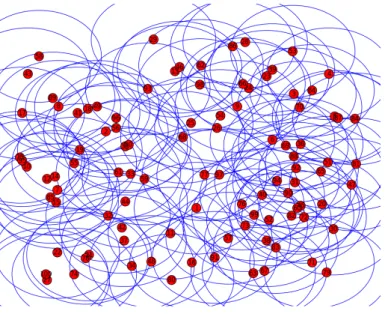
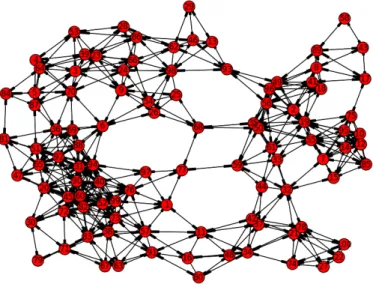
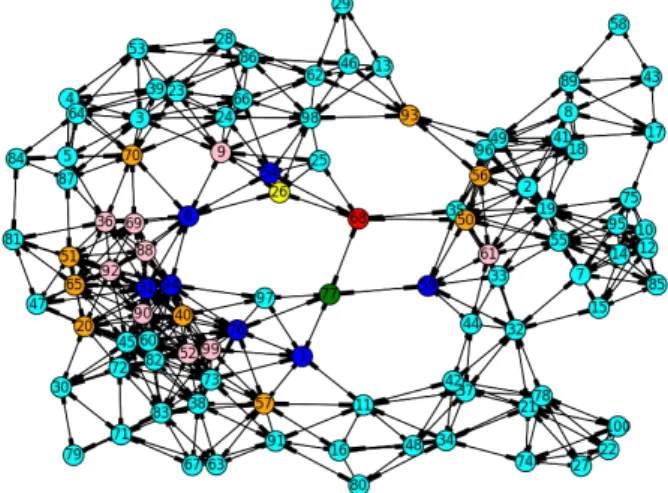
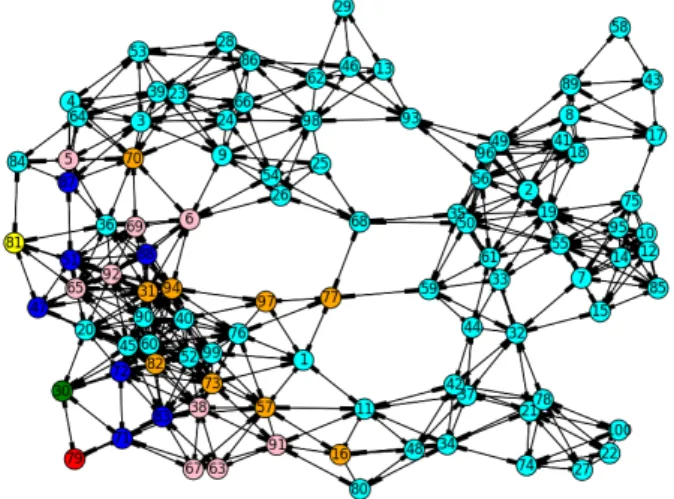
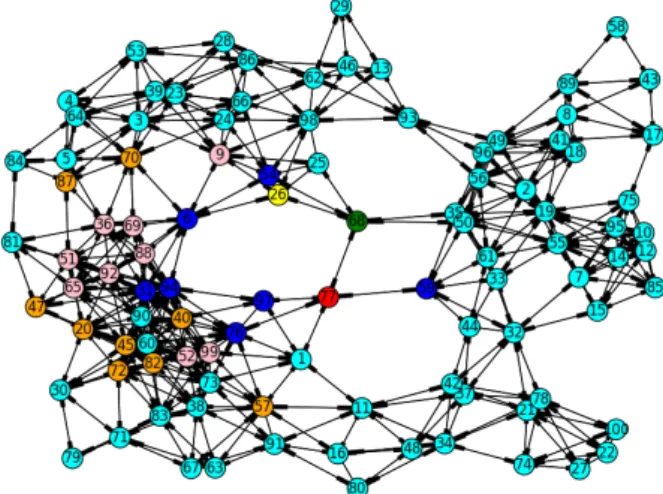
![Figure 1: Permutation 526134 of [6] with capacity 7](https://thumb-eu.123doks.com/thumbv2/9dokorg/1199257.88980/41.722.272.453.592.812/figure-permutation-capacity.webp)
